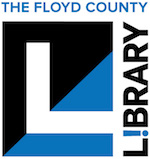Let’s take it from the top. What is a microhistory? Well, it’s what it sounds like: the history of something very small, studied in microscopic detail across time. So, instead of being a history of a given war or even a battle, taken in broad strokes, covering the bases of the event, a microhistory is more likely to focus on, say… bullets, from their creation to modern times. Or armor. Or flags.
These books often astound me because how could anyone even think of these topics, let alone research them?? Like, imagine googling “beer history” and combing through the results to find anything meaningful. But the specificity of a microhistory is their strength, giving the space to something usually overlooked. In that way the author can expose how their small subject may in fact loom quite large in our lives. So in celebration of that– and to help you get started if you’re intrigued– here are eight microhistories in the library collection.
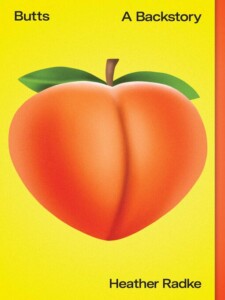 Butts: a Backstory by Heather Radke.
Butts: a Backstory by Heather Radke.
Whether we love them or hate them, think they’re sexy, think they’re strange, consider them too big, too small, or anywhere in between, humans have a complicated relationship with butts. It is a body part unique to humans, critical to our evolution and survival, and yet it has come to signify so much more: sex, desire, comedy, shame. A woman’s butt, in particular, is forever being assessed, criticized, and objectified, from anxious self-examinations trying on jeans in department store dressing rooms to enduring crass remarks while walking down a street or high school hallways. But why? In Butts: A Backstory, reporter, essayist, and RadioLab contributing editor Heather Radke is determined to find out. Spanning nearly two centuries, this book takes us from the performance halls of 19th-century London to the aerobics studios of the 1980s, the music video set of Sir Mix-a-Lot’s “Baby Got Back” and the mountains of Arizona, where every year humans and horses race in a feat of gluteal endurance. Along the way, she meets evolutionary biologists who study how butts first developed; models whose measurements have defined jean sizing for millions of women; and the fitness gurus who created fads like “Buns of Steel.” She also examines the central importance of race through figures like Sarah Bartmann, once known as the “Venus Hottentot,” Josephine Baker, Jennifer Lopez, and other women of color whose butts have been idolized, envied, and despised.
Get it in print, as an ebook on OverDrive, or as an eaudiobook on OverDrive.
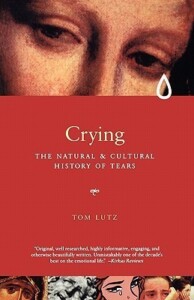 Crying: a Natural History of Tears by Tom Lutz.
Crying: a Natural History of Tears by Tom Lutz.
See what I mean about how the subjects are both tiny and massive at once? A single teardrop is smaller than a fingertip, but this book covers emotions, human physiology, gender expectations, and cultural differences around the world. And although we’ve all cried throughout our lives, starting literally in the moments after birth, it’s not a subject we think much about in our day-to-day lives. In this wide-ranging and provocative study, Tom Lutz looks at the ways people have understood weeping from the earliest known representations of tears in the fourteenth century B.C. to the tears found in today’s films. Drawing on works of literature, philosophy, art, and science from the writings of Plato and Darwin to the paintings of Picasso to modern medical journals, he unearths the multiple meanings and uses of tears.
Get it in print.
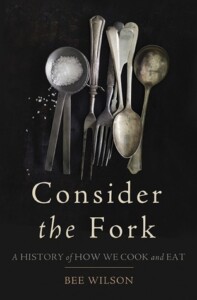 Consider the Fork: A History of How We Cook and Eat by Bee Wilson.
Consider the Fork: A History of How We Cook and Eat by Bee Wilson.
Since prehistory, humans have braved sharp knives, fire, and grindstones to transform raw ingredients into something delicious — or at least edible. But these tools have also transformed how we consume, and how we think about, our food. In Consider the Fork, award-winning food writer Bee Wilson takes readers on a wonderful and witty tour of the evolution of cooking around the world, revealing the hidden history of objects we often take for granted. Technology in the kitchen does not just mean the Pacojets and sous-vide machines of the modern kitchen, but also the humbler tools of everyday cooking and eating: a wooden spoon and a skillet, chopsticks and forks. Blending history, science, and personal anecdotes, Wilson reveals how our culinary tools and tricks came to be and how their influence has shaped food culture today. The story of how we have tamed fire and ice and wielded whisks, spoons, and graters, all for the sake of putting food in our mouths, Consider the Fork is truly a book to savor.
Get it in print, as an ebook on OverDrive, as an ebook on Hoopla, or as an eaudiobook on Hoopla.
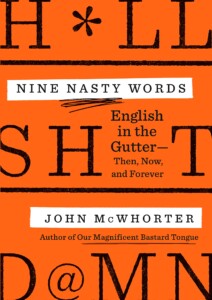 Nine Nasty Words: English in the Gutter: Then, Now, and Forever by John McWhorter.
Nine Nasty Words: English in the Gutter: Then, Now, and Forever by John McWhorter.
One of the preeminent linguists of our time examines the realms of language that are considered shocking and taboo in order to understand what imbues curse words with such power–and why we love them so much. Profanity has always been a deliciously vibrant part of our lexicon, an integral part of being human. In fact, our ability to curse comes from a different part of the brain than other parts of speech–the urgency with which we say “f&*k!” is instead related to the instinct that tells us to flee from danger. Language evolves with time, and so does what we consider profane or unspeakable. Nine Nasty Words is a rollicking examination of profanity, explored from every angle: historical, sociological, political, linguistic. In a particularly coarse moment, when the public discourse is shaped in part by once-shocking words, nothing could be timelier.
Get it in print, as an ebook on OverDrive, or as an eaudiobook on OverDrive.
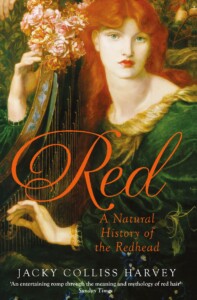 Red: a Natural History of the Redhead by Jacky Colliss Harvey.
Red: a Natural History of the Redhead by Jacky Colliss Harvey.
With an obsessive fascination that is as contagious as it is compelling, author Jacky Colliss Harvey (herself a redhead) begins her exploration of red hair in prehistory and traces the redhead gene as it made its way out of Africa with the early human diaspora to its emergence under Northern skies. She goes on to explore red hair in the ancient world; the prejudice manifested against red hair across medieval Europe; red hair during the Renaissance as both an indicator of Jewishness during the Inquisition and the height of fashion in Protestant England, under the reign of Henry VIII and Elizabeth I; the modern age of art and literature, and the first positive symbols of red hair in children’s characters; modern medicine and science and the genetic and chemical decoding of red hair; and finally, red hair in contemporary culture, from advertising and exploitation to “gingerism” and the new movement against bullying.
Get it in print or as an ebook on Hoopla.
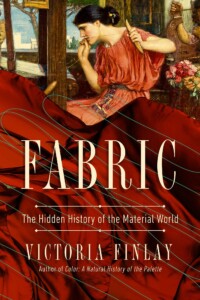 Fabric: the Hidden History of the Material World by Victoria Finlay.
Fabric: the Hidden History of the Material World by Victoria Finlay.
How is a handmade fabric helping save an ancient forest? Why is a famous fabric pattern from India best known by the name of a Scottish town? How is a Chinese dragon robe a diagram of the whole universe? What is the difference between how the Greek Fates and the Viking Norns used threads to tell our destiny? In Fabric, bestselling author Victoria Finlay spins us round the globe, weaving stories of our relationship with cloth and asking how and why people through the ages have made it, worn it, invented it, and made symbols out of it. And sometimes why they have fought for it. She beats the inner bark of trees into cloth in Papua New Guinea, fails to handspin cotton in Guatemala, visits tweed weavers at their homes in Harris, and has lessons in patchwork-making in Gee’s Bend, Alabama – where in the 1930s, deprived of almost everything they owned, a community of women turned quilting into an art form. She began her research just after the deaths of both her parents –and entwined in the threads she found her personal story too. Fabric is not just a material history of our world, but Finlay’s own journey through grief and recovery.
Get it in print, as an eaudiobook on OverDrive, as an ebook on Hoopla, or as an eaudiobook on Hoopla.
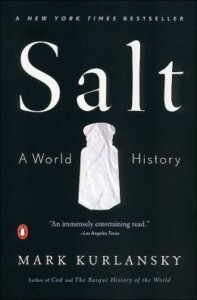 Salt: a World History by Mark Kurlansky.
Salt: a World History by Mark Kurlansky.
Kurlansky is considered the king of the microhistory, having written on topics as diverse as cod, paper, milk, and nonviolence. But in my opinion he’s at the height of his power with his book about a common household item with a long and intriguing history: salt. The only rock we eat, salt has shaped civilization from the very beginning, and its story is a glittering, often surprising part of the history of humankind. A substance so valuable it served as currency, salt has influenced the establishment of trade routes and cities, provoked and financed wars, secured empires, and inspired revolutions. Populated by colorful characters and filled with an unending series of fascinating details, Salt is a supremely entertaining, multi-layered masterpiece.
Get it in print, large print, either of two ebook editions on OverDrive, as an eaudiobook on OverDrive, or as an eaudiobook on Hoopla.
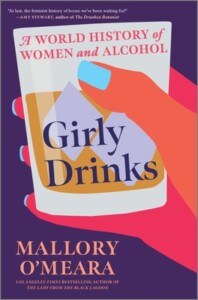 Girly Drinks: a World History of Women and Alcohol by Mallory O’Meara.
Girly Drinks: a World History of Women and Alcohol by Mallory O’Meara.
Strawberry daiquiris. Skinny martinis. Vodka sodas with lime. These are the cocktails that come in sleek-stemmed glasses, bright colors and fruity flavors–these are the Girly Drinks. From the earliest days of civilization, alcohol has been at the center of social rituals and cultures worldwide. But when exactly did drinking become a gendered act? And why have bars long been considered “places for men” when, without women, they might not even exist? With whip-smart insight and boundless curiosity, Girly Drinks unveils an entire untold history of the female distillers, drinkers and brewers who have played a vital role in the creation and consumption of alcohol, from ancient Sumerian beer goddess Ninkasi to iconic 1920s bartender Ada Coleman. Filling a crucial gap in culinary history, O’Meara dismantles the long-standing patriarchal traditions at the heart of these very drinking cultures, in the hope that readers everywhere can look to each celebrated woman in this book–and proudly have what she’s having.
Get it in print, as an ebook on OverDrive, as an eaudiobook on OverDrive, as an ebook on Hoopla, or as an eaudiobook on Hoopla.
